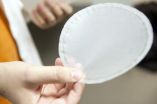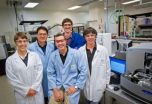(Press-News.org) Philadelphia, Pa. (October 23, 2012) - People who lift weights are less likely to have metabolic syndrome—a cluster of risk factors linked to heart disease and diabetes, reports a study in the October issue of The Journal of Strength and Conditioning Research, official research journal of the National Strength and Conditioning Association (NSCA). The journal is published by Lippincott Williams & Wilkins, a part of Wolters Kluwer Health.
"Lifting weights may play a role in reducing the prevalence and risk of metabolic syndrome among U.S. adults," according to the study by Peter M. Magyari, PhD, HFS, CSCS, and James R. Churilla, PhD, MPH, MS, RCEP, CSCS, FACSM of Brooks College of Health, University of North Florida, Jacksonville.
About Nine Percent of Americans Lift Weights…
The researchers analyzed data from the 1999-2004 National Health and Nutrition Examination Survey (NHANES), an ongoing, nationally representative study of health risk factors. In the survey, respondents were simply asked whether they lifted weights; the responses were analyzed for association with the presence of metabolic syndrome.
Metabolic syndrome is a cluster of risk factors linked to increased rates risk of cardiovascular disease and diabetes. People with at least three out of five risk factors—large waist circumference (more than 40 inches for men and 35 inches for women), high triglyceride levels, reduced levels of high-density lipoprotein cholesterol (HDL, or "good" cholesterol), elevated blood pressure, and high glucose levels—are considered to have metabolic syndrome.
Of 5,618 U.S. adults who had fasting blood samples for analysis, 8.8 percent answered yes to the question about lifting weights. Lifting weights was about twice as common in men than women: 11.2 versus 6.3 percent. It was also more common among younger people—lifting weights became less frequent for people aged 50 years and older.
White and black Americans were about equally likely to lift weights, while Mexican Americans were least likely. People at higher socioeconomic levels were also more likely to say they lifted weights.
…Reducing the Odds of Metabolic Syndrome by 37 Percent
This cross-sectional analysis of the 1999-2004 NHANES data found a lower prevalence of metabolic syndrome among people who reported lifting weights: 24.6 percent, compared to 37.3 percent in those who did not lift weights. After adjustment for demographic factors, lifting weights was associated with a 37 percent reduction in the odds of metabolic syndrome.
Several recent studies have evaluated the impact of exercise for prevention and treatment of metabolic syndrome. Resistance exercise, including weight-lifting, may have protective effects. Research has linked greater muscle strength and muscle mass to lower rates of metabolic syndrome. Since lifting weights increases muscle strength and mass, it might also help to decrease the development of metabolic syndrome.
The new study provides population-level data showing that people who lift weights are less likely to have the risk factors that make up metabolic syndrome. This suggests that incorporating weight lifting or other forms of resistance exercise into physical activity programs might be an effective way to reduce the risk of metabolic syndrome, both for individuals and in the population.
"Exercise professionals should strongly encourage the activity of lifting weights among adults of all ages to promote metabolic health," Drs Magyari and Churilla conclude. These efforts should focus on groups with lower rates of weight lifting: women, older adults, Mexican Americans, and lower-income people. The authors acknowledge some significant limitations of their study—such as a lack of detailed information on weight lifting and other types of resistance exercise, including manual labor.
###
About The Journal of Strength and Conditioning Research
The editorial mission of The Journal of Strength and Conditioning Research (JSCR) is to advance the knowledge about strength and conditioning through research. A unique aspect of this journal is that it includes recommendations for the practical use of research findings. While the journal name identifies strength and conditioning as separate entities, strength is considered a part of conditioning. The journal wishes to promote the publication of peer-reviewed manuscripts which add to our understanding of conditioning and sport through applied exercise science. The JSCR is the official research journal of the National Strength and Conditioning Association.
About Lippincott Williams & Wilkins
Lippincott Williams & Wilkins (LWW) is a leading international publisher of trusted content delivered in innovative ways to practitioners, professionals and students to learn new skills, stay current on their practice, and make important decisions to improve patient care and clinical outcomes. LWW is part of Wolters Kluwer Health, a leading global provider of information, business intelligence and point-of-care solutions for the healthcare industry. Wolters Kluwer Health is part of Wolters Kluwer, a market-leading global information services company with 2011 annual revenues of €3.4 billion ($4.7 billion).
Lifting weights protects against metabolic syndrome
Population study shows lower rate of cardiovascular risk factors in those who lift weights
2012-10-23
ELSE PRESS RELEASES FROM THIS DATE:
Nanofibrillar cellulose film to ease performing medical tests
2012-10-23
Researchers at Aalto University in Finland have succeeded in developing a durable and affordable nanofibrillar cellulose film platform to support medical testing. New environmentally friendly, reliable nanofibrillar cellulose (NFC) platforms are more diverse than plastic films. New film can be made, for instance, hydrophobic, hydrophilic and the electric charge can be changed. This will enhance the possibility of conducting thousands of different medical tests at home or in physicians' receptions instead of waiting for results from laboratories.
A platform is coated with ...
Migratory birds can spread haemorrhagic fever
2012-10-23
A type of haemorrhagic fever that is prevalent in Africa, Asia, and the Balkans has begun to spread to new areas in southern Europe. Now Swedish researchers have shown that migratory birds carrying ticks are the possible source of contagion. The discovery is being published in the US journal Emerging Infectious Diseases.
Crimean-Congo Haemorrhagic fever is a serious disease that begins with influenza-like symptoms but can develop into a very serious condition with high mortality (30%). The disease occurs in Africa, Asia, and the Balkans but it has recently started to ...
Low adoption by large hospital ICUs of catheter-associated urinary tract infection precautions
2012-10-23
NEW YORK –Hospital size matters when it comes to intensive care units (ICUs) adopting even the most routine prevention policies for catheter-associated urinary tract infections (CAUTI), according to a new study from researchers at Columbia University School of Nursing, published this month in the American Journal of Infection Control. The study found that large hospitals -- those with more than 500 beds --had a 1.5 higher average rate of CAUTI than hospitals with 500 beds or less. Since larger hospitals, particularly teaching hospitals treat patients who are often sicker, ...
Tiny pores in graphene could give rise to membranes
2012-10-23
CAMBRIDGE, Mass. — Much has been made of graphene's exceptional qualities, from its ability to conduct heat and electricity better than any other material to its unparalleled strength: Worked into a composite material, graphene can repel bullets better than Kevlar. Previous research has also shown that pristine graphene — a microscopic sheet of carbon atoms arranged in a honeycomb pattern — is among the most impermeable materials ever discovered, making the substance ideal as a barrier film.
But the material may not be as impenetrable as scientists have thought. By engineering ...
Are schizophrenia and autism close relations?
2012-10-23
Autism Spectrum Disorders (ASD), a category that includes autism, Asperger Syndrome, and Pervasive Developmental Disorder, are characterized by difficulty with social interaction and communication, or repetitive behaviors. The U.S. Centers for Disease Control and Management says that one in 88 children in the US is somewhere on the Autism spectrum — an alarming ten-fold increase in the last four decades.
New research by Dr. Mark Weiser of Tel Aviv University's Sackler Faculty of Medicine and the Sheba Medical Center has revealed that ASD appears share a root cause with ...
NASA sees active region on the sun emit another flare
2012-10-23
VIDEO:
Video of the Oct. 22, 2012, solar flare as captured by NASA's Solar Dynamics Observatory in the 131 and 304 Angstrom wavelengths. LINK TO HIGHEST RESOLUTION VIDEO: ...
Quasar may be embedded in unusually dusty galaxy
2012-10-23
Hubble astronomers have looked at one of the most distant and brightest quasars in the universe and are surprised by what they did not see: the underlying host galaxy of stars feeding the quasar. The best explanation is that the galaxy is shrouded in so much dust that the stars are completely hidden everywhere. Astronomers believe that the James Webb Space Telescope will reveal the galaxy.
All but the very first galaxies contain some dust—the early universe was dust-free until the first generation of stars started making dust through nuclear fusion. As these stars aged ...
Is declining medical imaging use driving up hospital stays and medical costs?
2012-10-23
A new report by the Harvey L. Neiman Health Policy Institute shows that the length of the average hospital stay in the United States has increased at the same time as use of medical imaging scans has declined. It is unclear if the trends are related, but potentially important, as hospital admissions are among the largest, and fastest growing, health care costs. More research is needed to assess the potential negative impact of government and private insurer imaging reductions on overall medical costs and patient safety.
"Lawmakers, regulators and medical professionals ...
Making transport a driver for development in Africa
2012-10-23
A new report by a panel of international experts highlights policies to improve air quality road safety and congestion, supporting African development.
Transport is playing a big role in delivering economic development to Africa. But as the demand for transport grows and cities expand, policy makers need to tackle transport challenges to make sure that all parts of society can benefit from this central driver of jobs and growth.
"Transport policies in Africa are of critical importance to the delivery of sustainable cities, healthy citizens and poverty eradication," ...
Training your robot the PaR-PaR way
2012-10-23
Teaching a robot a new trick is a challenge. You can't reward it with treats and it doesn't respond to approval or disappointment in your voice. For researchers in the biological sciences, however, the future training of robots has been made much easier thanks to a new program called "PaR-PaR."
Nathan Hillson, a biochemist at the U.S. Department of Energy (DOE)'s Joint BioEnergy Institute (JBEI), led the development of PaR-PaR, which stands for Programming a Robot. PaR-PaR is a simple high-level, biology-friendly, robot-programming language that allows researchers to ...
LAST 30 PRESS RELEASES:
Longest observation of an active solar region
Why nail-biting, procrastination and other self-sabotaging behaviors are rooted in survival instincts
Regional variations in mechanical properties of porcine leptomeninges
Artificial empathy in therapy and healthcare: advancements in interpersonal interaction technologies
Why some brains switch gears more efficiently than others
UVA’s Jundong Li wins ICDM’S 2025 Tao Li Award for data mining, machine learning
UVA’s low-power, high-performance computer power player Mircea Stan earns National Academy of Inventors fellowship
Not playing by the rules: USU researcher explores filamentous algae dynamics in rivers
Do our body clocks influence our risk of dementia?
Anthropologists offer new evidence of bipedalism in long-debated fossil discovery
Safer receipt paper from wood
Dosage-sensitive genes suggest no whole-genome duplications in ancestral angiosperm
First ancient human herpesvirus genomes document their deep history with humans
Why Some Bacteria Survive Antibiotics and How to Stop Them - New study reveals that bacteria can survive antibiotic treatment through two fundamentally different “shutdown modes”
UCLA study links scar healing to dangerous placenta condition
CHANGE-seq-BE finds off-target changes in the genome from base editors
The Journal of Nuclear Medicine Ahead-of-Print Tip Sheet: January 2, 2026
Delayed or absent first dose of measles, mumps, and rubella vaccination
Trends in US preterm birth rates by household income and race and ethnicity
Study identifies potential biomarker linked to progression and brain inflammation in multiple sclerosis
Many mothers in Norway do not show up for postnatal check-ups
Researchers want to find out why quick clay is so unstable
Superradiant spins show teamwork at the quantum scale
Cleveland Clinic Research links tumor bacteria to immunotherapy resistance in head and neck cancer
First Editorial of 2026: Resisting AI slop
Joint ground- and space-based observations reveal Saturn-mass rogue planet
Inheritable genetic variant offers protection against blood cancer risk and progression
Pigs settled Pacific islands alongside early human voyagers
A Coral reef’s daily pulse reshapes microbes in surrounding waters
EAST Tokamak experiments exceed plasma density limit, offering new approach to fusion ignition
[Press-News.org] Lifting weights protects against metabolic syndromePopulation study shows lower rate of cardiovascular risk factors in those who lift weights



